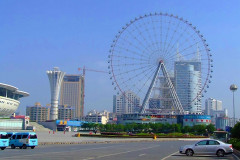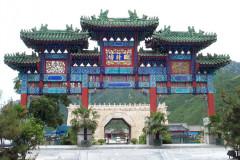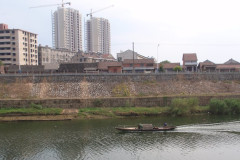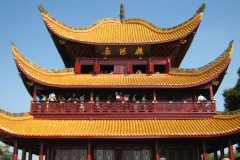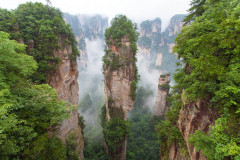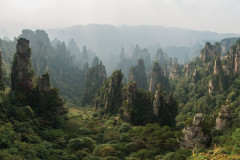Hunan
Description
Hunan Province is a province of the People's Republic of China. It is located in South Central China, south of the middle course of the Yangtze River, and south of Lake Dongting (hence the name Hunan, which means "south of the lake"). Hunan is sometimes called for short and officially abbreviated as "湘" (pinyin: Xiāng), named after the Xiang River which runs through the province.
Hunan borders Hubei Province in the north, Jiangxi Province to the east, Guangdong Province to the southeast, Guangxi Province to the southwest, Guizhou Province to the west, and Chongqing to the northwest. The provincial capital is Changsha.
History
Hunan's primeval forests were first occupied by the ancestors of the modern Miao, Tujia, Dong and Yao peoples. It entered the written history of China around 350 BC, when under the kings of the Zhou Dynasty, it became part of the State of Chu. After Qin conquered the Chu heartland in 278 BC, the region came under the control of Qin, and then the Han dynasty. At this time, and for hundreds of years thereafter, it was a magnet for migration of Han Chinese from the north, who displaced or assimilated the indigenous people, cleared forests and began farming rice in the valleys and plains. The agricultural colonization of the lowlands was carried out in part by the Han state, which managed river dikes to protect farmland from floods. To this day many of the small villages in Hunan are named after the Han families who settled there. Migration from the north was especially prevalent during the Eastern Jin Dynasty and the Southern and Northern Dynasties Periods, when nomadic invaders pushed these peoples south.
During the Five Dynasties and Ten Kingdoms Period, Hunan was home to its own independent regime, Ma Chu.
Hunan and Hubei became a part of the province of Huguang (湖廣) until the Qing dynasty. Hunan province was created in 1664 from Huguang, renamed to its current name in 1723.
Hunan became an important communications center due to its position on the Yangzi River. It was an important centre of scholarly activity and Confucian thought, particularly in the Yuelu Academy in Changsha. It was also on the Imperial Highway constructed between northern and southern China. The land produced grain so abundantly that it fed many parts of China with its surpluses. The population continued to climb until, by the nineteenth century, Hunan became overcrowded and prone to peasant uprisings. Some of the uprisings, such as the ten-year Miao Rebellion of 1795–1806, were caused by ethnic tensions. The Taiping Rebellion began in the south in Guangxi Province in 1850. The rebellion spread into Hunan and then further eastward along the Yangzi River valley. Ultimately, it was a Hunanese army under Zeng Guofan who marched into Nanjing to put down the uprising in 1864.
Hunan was relatively quiet until 1910 when there were uprisings against the crumbling Qing dynasty, which were followed by the Communist's Autumn Harvest Uprising of 1927. It was led by Hunanese native Mao Zedong, and established a short-lived Hunan Soviet in 1927. The Communists maintained a guerrilla army in the mountains along the Hunan-Jiangxi border until 1934. Under pressure from the Nationalist Kuomintang (KMT) forces, they began the Long March to bases in Shaanxi Province. After the departure of the Communists, the KMT army fought against the Japanese in the second Sino-Japanese war. They defended the Changsha until it fell in 1944. Japan launched Operation Ichigo, a plan to control the railroad from Wuchang to Guangzhou (Yuehan Railway). Hunan was relatively unscathed by the civil war that followed the defeat of the Japanese in 1945. In 1949, the Communists returned once more as the Nationalists retreated southward.
As Mao Zedong's home province, Hunan supported the Cultural Revolution of 1966–1976. However, it was slower than most provinces in adopting the reforms implemented by Deng Xiaoping in the years that followed Mao's death in 1976.
Former Chinese Premier Zhu Rongji is also Hunanese, as are the late President Liu Shaoqi and the late Marshal Peng Dehuai.
Geography
Hunan is located on the south bank of the Yangtze River, about half way along its length, situated between 108° 47'–114° 16' east longitude and 24° 37'–30° 08' north latitude. It covers an area of 211,800 square kilometres (81,800 sq mi), making it the 10th largest provincial-level division. The east, south and west sides of the province are surrounded by mountains and hills, such as the Wuling Mountains to the northwest, the Xuefeng Mountains to the west, the Nanling Mountains to the south, and the Luoxiao Mountains to the east. The mountains and hills occupy more than 80% of the area and plains comprises less than 20% of the whole province.
The Xiang, the Zi, the Yuan and the Lishui Rivers converge on the Yangtze River at Lake Dongting in the north of Hunan. The center and northern parts are somewhat low and a U-shaped basin, open in the north and with Lake Dongting as its center. Most of Hunan lies in the basins of four major tributaries of the Yangtze River.
Lake Dongting is the largest lake in the province and the second largest freshwater lake of China.
The Xiaoxiang area and Lake Dongting figure prominently in Chinese poetry and paintings, particularly during the Song Dynasty when they were associated with officials who had been unjustly dismissed.
Changsha (which means "long sands") was an active ceramics district during the Tang Dynasty, its tea bowls, ewers and other products mass-produced and shipped to China's coastal cities for export abroad. An Arab dhow dated to the 830s and today known as the Belitung Shipwreck was discovered off the small island of Belitung, Indonesia with more than 60,000 pieces in its cargo. The salvaged cargo is today housed in nearby Singapore.
Hunan's climate is subtropical, and, under the Köppen climate classification, is classified as being humid subtropical (Köppen Cfa), with short, cool, damp winters, very hot and humid summers, and plenty of rainfall. January temperatures average 3 to 8 °C (37 to 46 °F) while July temperatures average around 27 to 30 °C (81 to 86 °F). Average annual precipitation is 1,200 to 1,700 millimetres (47 to 67 in).
Culture
Xiang Chinese (湘語) is the biggest native language to Hunan province, and it is also a group of Chinese dialects spoken in most parts of Hunan and in a few adjacent areas.
Hunanese cuisine is noted for its use of chili peppers.
Huaguxi is a local form of Chinese opera that is very popular in Hunan province.
Nü shu is a writing system that was used exclusively among women in Jiangyong County.
Hunan's culture industry generated 87 billion yuan (US$11.76 billion) in economic value in 2007, a major contributor to the province's economic growth. The industry accounts for 7.5 percent of the region's GDP - 0.9 percentage points higher than the previous year.
Tourism
Located in the south central part of the Chinese mainland, Hunan has long been known for its natural beauty. It is surrounded by mountains on the east, west, and south, and by the Yangtze River on the north. Its mixture of mountains and water makes it among the most beautiful provinces in China. For thousands of years, the region has been a major center of agriculture, growing rice, tea, and oranges. China's first all glass suspension bridge was also opened in Hunan, in Shiniuzhai National Geological Park.
- Shaoshan, the village where Mao Zedong was born
- Wulingyuan Scenic and Historic Interest Area (World Heritage Site)
- Yueyang Tower in Yueyang
- Mount Heng in Hengyang
- Zhangjiajie
- Fenghuang County in Xiangxi Prefecture
- Hong Jiang

